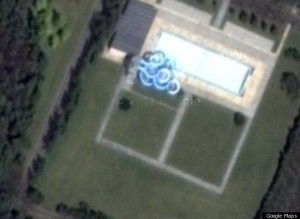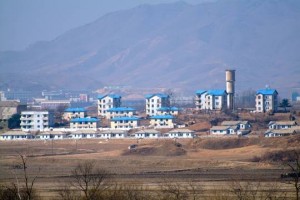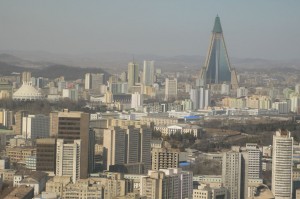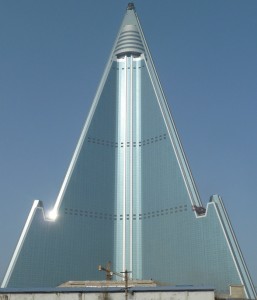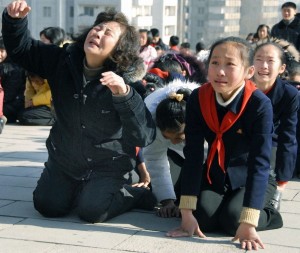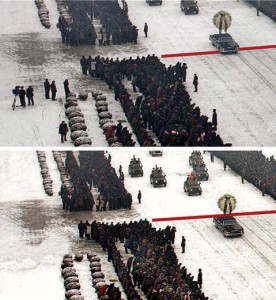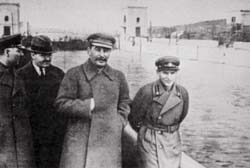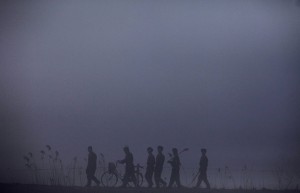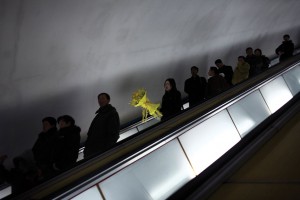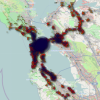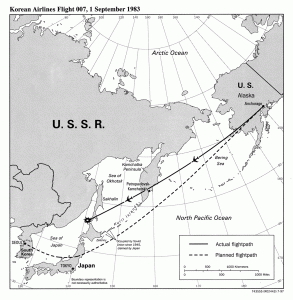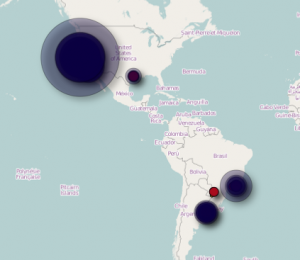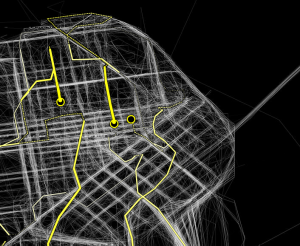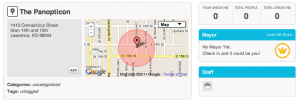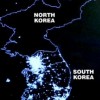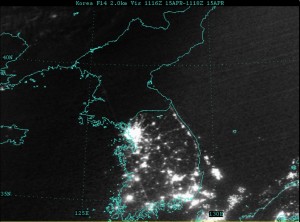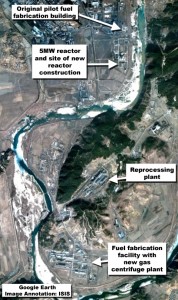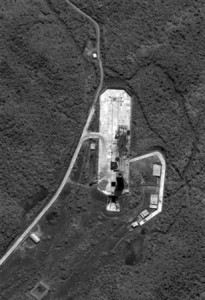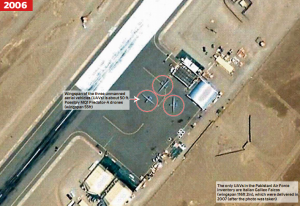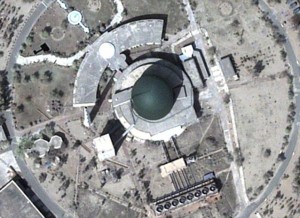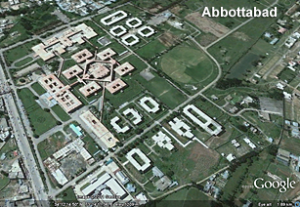When one thinks of North Korea, “funhouse” is probably not at the top of the vocabulary–but Kim Jong-il had waterslides.
Kim’s Funhouse
Courtesy of NKeconwatch (featured in prior Gestaltist posts), the pool at one of Kim’s numerous estates includes what appears to be a waterslide:
Perhaps soon many more Pyongyang “elites” will have their own funhouse(s). The 2012 Strong and Prosperous Nation (Kangsong Taeguk) measures marking the centennial of Kim Il-sung’s birth will bring Pyongyang a new 100,000-unit housing development cleverly called “The Development Project of 100,000 Housing Units in Pyongyang”. The development will feature a recreation area which will include–you guessed it–waterslides. Photos of the construction can be found here.
North Korea’s “Real” Potemkin Village
Just north of the DMZ lies Kijong-dong, an apparently bustling town within view of South Korean soldiers and tourists. Except this town has no residents, and the houses have no furniture, and apparently the buildings have no glass on the windows. It’s purpose appears to be propagandistic: it was built just after the war, apparently to lure South Korean sentinels across the border. Kijong-dong is a Potemkin village more real than the metaphor’s apocryphal source. And no one gets to live in a Potemkin village.
“The Hotel of Doom”
No one gets to stay in the Ryugyong Hotel either; no one ever has. It’s been 25 years.
The hotel was begun in 1987. Given its setting and mandate, its semiotic function (that is, beside just lodging and making money in some fashion) is clear. It’s huge (105 stories, 3,900,000 square feet). But construction stalled more than once, famine took hold, and for more than 15 years the Pyongyang skyline featured this pyramidal windowless derelict.
But construction (after a fashion) resumed in 2008, thanks to a foreign investor that’s also engaged in creating North Korea’s cellular data network. Work on the exterior and cladding is complete; though it remains dark, the Ryugyong is no longer windowless.
While a bit hysterical, I have a morbid fascination with Esquire’s formulation, “The Hotel of Doom”. Well, perhaps these changes will be more than superficial. The new angel is an Egyptian telecom, Orascom.. According to The Independent:
It would cost up to $2bn (£1bn) to finish the Ryugyong Hotel and make it safe, according to estimates in South Korea’s media. That is equivalent to about 10 per cent of the North’s annual economic output. Bruno Giberti, the associate head of California Polytechnic State University’s department of architecture, said the project was typical of what has been produced recently by many cities which were trying to show their emerging wealth by constructing gigantic edifices that were not related in scale to anything else around them.
When Dubai ran into trouble, Burj Dubai became Burj Khalifa after Abu Dhabi bailed Dubai out. Perhaps we’ll end up with an empty but at least covered Hotel Sawiris?
Are They Serious?“Who knows does not speak / who speaks does not know”–this blog included (here I am, speaking, after all). What we do know is that the imagery we do see of swooning mourners gnashing teeth is almost entirely from Pyongyang–and merely living in Pyongyang affords a North Korean a degree of privilege and comfort not available elsewhere.. And while the crowds may seem huge, there’s a substantial bit of looping involved.
The article cites B.R. Meyers on the histrionics issue. Listen to an interview with him on the topic at NPR.
This whole wailing and carrying on is really a propaganda exercise in its own right. It’s meant to convey not just the message that these people loved their leader but also the message that this is a uniquely vulnerable child race whose emotions run deeper than the emotions of people in other countries. And they’re faking a very infantile kind of grief.
[youtube]http://www.youtube.com/watch?v=dowA-daEESQ[/youtube]
In the interview, Meyers asserts that the eldest Kim’s doctrine of “juche” (akin to self reliance) is a fraud. Indeed, from nuclear extortion in exchange for financial aid and heavy fuel oil to pleas for food aid (these are legitimate in that famine is a real problem for North Koreans–though not so much for the ones we see wailing on TV), passing the hat and blackmail are a means of getting the things that would allow an even slightly more open country to maintain legitimacy.
The Daily NK reported that mourners who were judged to have been “insincere” were being sent to labor camps:
The authorities are handing down at least six months in a labor-training camp to anybody who didn’t participate in the organized gatherings during the mourning period, or who did participate but didn’t cry and didn’t seem genuine.
That report has been officially denied, having a statement be declared “official” isn’t exactly a credibility-enhancer.
“Pyongyang-ology”
It’s the new “Kremlinology” (referencing the Cold War discipline of analyzing any trace of information leaking from the USSR–particularly photography–to get clues of who might be favored by whom by inference of who’s standing next to Krushchev at a May Day parade). Similarly with North Korea, ever since Kim Jong-un was elevated to general status ahead of and named to vice-chair to the Central Military Committee ahead of the 2010 Worker’s Party of Korea conference, the “who is standing next to him” question has been vital. Kim’s uncle Jang Song Thaek not only scores high on the proximity scale but also first appeared in military uniform in those photos. Ri Yong Ho (Army Chief of Staff) is one of the runners-up.
Though most probably this photo was altered for aesthetic reasons, it brings to mind the Stalin-era alteration of photos to remove those no longer in favor (or worse). Much ink has been spilled on this topic; this article from the Hoover Institution summarizes it nicely.
Condolences
Clues of political positioning are also given by watching who has offerred condolences, and what form they took. Even a local news weatherman may get to sign autographs at a county fair, mind you.
From the US, Bill Richardson and Jimmy Carter both offered condolences (as private citizens); there wasn’t any official condolence. Perhaps interestingly, the UN has been to the impromptu memorial at the DPRK mission to the UN, and the UN HQ in Pyongyang flew their flag at half-staff. Ban Ki-moon also offered condolences,but to the people of North Korea, not the government. It’s an important distinction, akin to Obama’s messages to the *people* of Iran. I’m fond of this quote in Foreign Policy:
‘This case is unique,’ a senior U.N. official explained to Turtle Bay. “Everything in that country is unique. I can’t think of another country where the head of state is permanently dead.” (the eldest Kim is constitutionally declared to be North Korea’s “Eternal President”)
Scott Snyder of CFR has a nice list of events to watch for (in coming months and in general) that might offer clues as far as the hardiness of Kim Jong-un’s succession.
Glimpses
“Bonus” is Gestaltist code for “I am tired of writing” and/or “I have to go for now”. So, a bonus on this topic, a few links of photos from glimpses inside North Korea.
From the Boston Globe’s phenomenal Big Picture blog:
“Land of No Smiles”: from Foreign Policy:
http://publicintelligence.net/north-korea-and-the-strangest-show-on-earth/
http://www.telegraph.co.uk/news/picturegalleries/worldnews/8972862/Satellite-images-of-North-Korea-give-a-rare-glimpse-of-life-under-Kim-Jong-il.html


